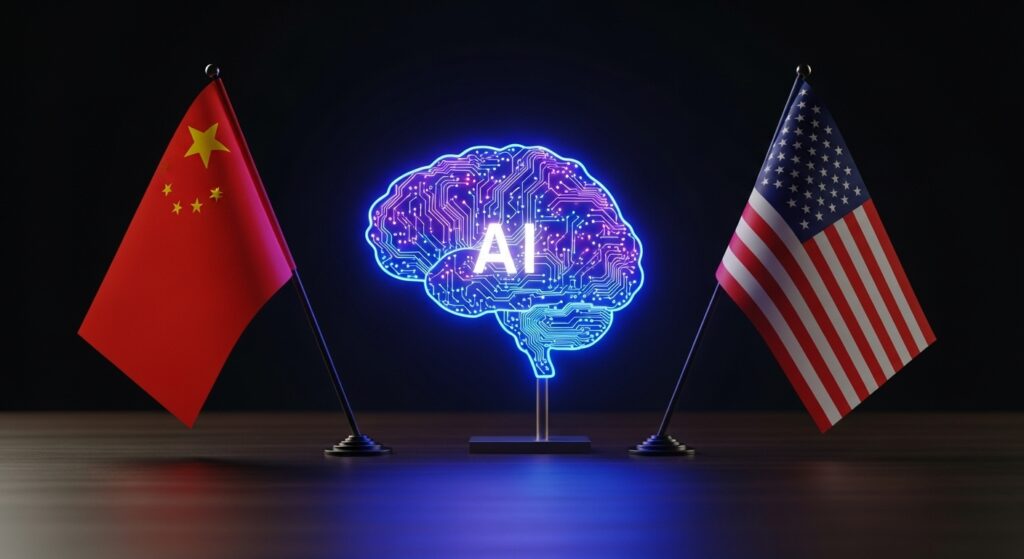Artificial Intelligence (A.I.) is no longer just a Silicon Valley story — it’s also a Beijing story. Over the past decade, China has been quietly and aggressively investing billions of dollars into A.I., with a clear goal: to close the gap with the United States and establish itself as an A.I. superpower.
From funding data centers and chips to nurturing thousands of startups, China’s strategy mirrors the industrial policies that helped it dominate electric vehicles, solar panels, and consumer electronics. But can this approach work in a fast-moving, unpredictable field like artificial intelligence?
Let’s break down how China is building its A.I. empire — and whether it can catch up to, or even surpass, the U.S.
🏗️ How China’s A.I. Strategy Works
In July 2024, when OpenAI blocked access to its advanced A.I. systems in China, many assumed this would slow Chinese progress. Instead, Chinese engineers quickly pivoted to open-source A.I. models — not just relying on American open-source tools but building their own.
By mid-2025, Chinese companies like Alibaba, DeepSeek, and Huawei released open-source systems that ranked among the world’s best. These efforts didn’t happen overnight — they were the product of a decade of deliberate planning and investment.
💵 Billions in State Investment
Unlike the U.S., where private companies like OpenAI, Meta, and Google dominate A.I. development, China’s government is actively financing nearly every layer of the A.I. stack:
- Chips & semiconductors: China has poured nearly $100 billion since 2014 into developing domestic chipmaking capabilities.
- Data centers & servers: Local governments fund massive infrastructure projects to support A.I. training needs.
- Talent & research: Beijing established dozens of government-financed labs to attract and train skilled engineers.
In April 2025, China earmarked another $8.5 billion for early-stage A.I. startups, while cities like Hangzhou set up specialized neighborhoods like Dream Town — effectively startup incubators on steroids.
📊 Local Incentives Driving Startups
The Chinese approach isn’t just about pouring money into big tech. Local governments compete to attract startups by offering subsidies, office space, and housing for employees.
For example, Deep Principle, a Hangzhou-based A.I. startup, received a $2.5 million subsidy simply for relocating to the city. Other startups report government assistance covering 10–15% of early-stage research costs — a huge advantage in a cash-hungry industry.

🖥️ Chips: The Weak Link
Despite all this investment, chips remain a weak point. U.S. export restrictions have made it difficult for Chinese companies to buy high-performance A.I. chips from Nvidia.
In response, Huawei and SMIC are racing to develop Chinese alternatives. But while these homegrown chips are improving, they still lag behind Nvidia’s cutting-edge hardware.
The goal seems to be to create a viable fallback: chips that are “good enough” to keep progress moving even if they can’t match Nvidia’s speed or efficiency yet.
🌐 Open-Source A.I.: China’s Secret Weapon
One of the most striking shifts in the past year has been China’s embrace of open-source A.I. models. Companies like Alibaba, ByteDance, and Baidu are now releasing powerful, publicly available A.I. systems.
Why?
- Open-source allows faster iteration and community improvement.
- It lowers costs and makes it easier for engineers globally to build on Chinese models.
- It circumvents restrictions on proprietary U.S. systems like GPT-4.
This strategy may also help China set the standards for global A.I. use — particularly in developing markets where American companies face regulatory or competitive challenges.

🔍 Can China Overtake the U.S.?
It’s clear China has made incredible progress, closing what many thought was an insurmountable gap. But challenges remain:
- Too many startups competing for the same resources.
- Bureaucratic inefficiencies in shifting focus as technology evolves.
- Lagging chip performance.
A.I. is not a stable industry like steel or shipbuilding — it evolves rapidly. China’s top-down, state-driven approach has succeeded in hardware and manufacturing, but whether it works in such a dynamic field is still an open question.
Still, with billions invested and a vast domestic market hungry for A.I. applications, China’s ambitions are impossible to ignore.

📝 Final Thoughts
While the U.S. remains ahead in the A.I. race for now, China’s aggressive investments and innovative open-source strategy are reshaping the playing field.
By aligning government resources, corporate innovation, and open access, Beijing hopes to not just catch up but redefine the future of A.I. on its own terms.
The next few years will show if that bet pays off — but one thing’s for sure: the race is far from over.
Why is China investing so heavily in A.I.?
China wants to reduce its reliance on U.S. technology and become an A.I. leader, boosting its economy and global influence.
How much has China spent on A.I. so far?
Since 2014, China has spent nearly $100 billion on semiconductors and billions more on A.I. startups, infrastructure, and research labs.
What is China’s advantage in A.I. development?
China combines government funding, massive data resources, and an open-source strategy to accelerate A.I. innovation.
Is China ahead of the U.S. in A.I.?
Not yet, but the gap is closing fast as Chinese firms release competitive models and invest heavily in R&D.
